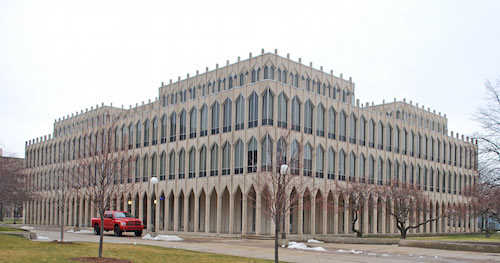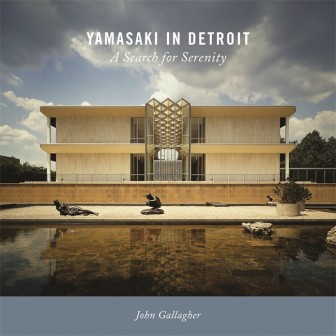
The Wayne State University College of Education building in Detroit was designed by Minoru Yamasaki. Image: Creative Commons
Review
By Amanda Proscia
John Gallagher profiles Japanese-American architect Minoru Yamasaki in his book Yamasaki in Detroit: A Search for Serenity.
Perhaps best known for his design of the World Trade Center in New York, a number of Yamasaki’s designs adorn Detroit’s urban landscape, including the One Woodward Avenue building (formerly the Michigan Consolidated Gas building).
The city was Yamasaki’s adopted home. He moved from New York to a Detroit suburb in his mid-thirties and remained in the area until his death in 1986.
“The great irony is Yamasaki is known as the architect of arguably the most gargantuan project in the U.S., but mostly all of his other projects were very modest,” Gallagher said.
Gallagher, an architecture reporter for the Detroit Free Press, covered Wayne State University’s restoration of the reflection pool at Yamasaki’s McGregor Memorial Conference Center. When editors at Wayne State University Press asked him to write a book about Yamasaki, “I didn’t need much urging,” he said.

The Yamasaki in Detroit: A Search for Serenity book cover.
Gallagher chronicled Yamasaki’s humble beginnings as the child of two Japanese immigrants, his exploitive summer job at an Alaskan salmon cannery, the discrimination he and his family faced in the years following Pearl Harbor and how these factors contributed to Yamasaki’s drive to be successful.
“I thought I knew a lot about Yamasaki — until I started researching for this book,” Gallagher said.
He interviewed Yamasaki’s colleagues and studied the architect’s autobiography.
“He left behind a very rich written background of what he believed and how he tried to achieve what he achieved,” Gallagher said.
Much of the book centers on Yamasaki’s intense ambition and his quest for his own style.
“It was a very deliberate artistic journey he took in really trying to achieve an artistic vision,” Gallagher said.
His style evolved into practical, innovative design accompanied by tranquil spaces. Yamasaki sought to humanize architecture, incorporating large plazas, pools and gardens into his designs for a serene escape within the site.
The College of Creative Studies building in Detroit is exemplary of his signature style. It is an unassuming two-story structure with a center skylight, surrounded by lush landscaping and enclosed in a brick screening wall.
Gallagher sees the book as a way to chronicle the architect’s contribution to design, he said.
“I think the book is able to revive a figure who was going to dissolve into history — if it helps people understand what Yamasaki added to the field of architecture, I’ll be happy.”
The book is available through the Wayne State University Press for $39.99.
Amanda Proscia is a reporter for Great Lakes Echo